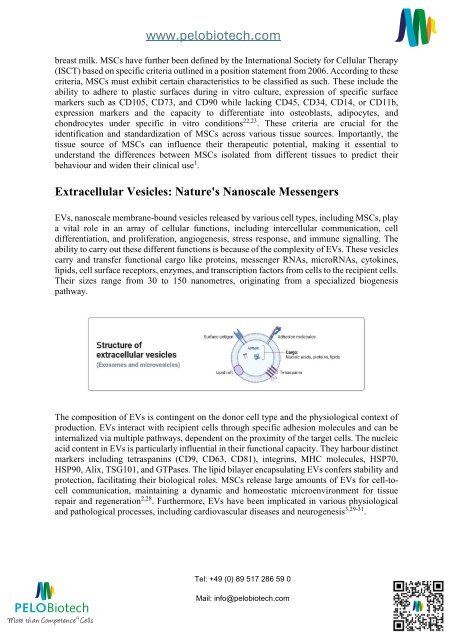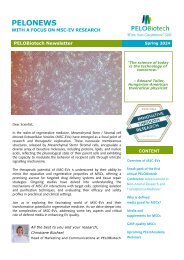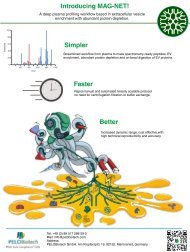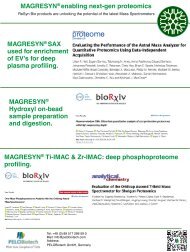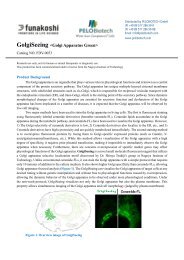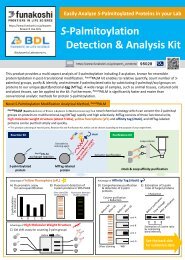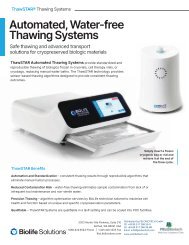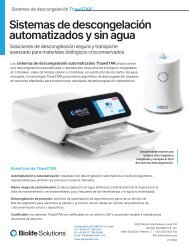Review: MSCs and Exosomes Production
You also want an ePaper? Increase the reach of your titles
YUMPU automatically turns print PDFs into web optimized ePapers that Google loves.
www.pelobiotech.com<br />
breast milk. <strong>MSCs</strong> have further been defined by the International Society for Cellular Therapy<br />
(ISCT) based on specific criteria outlined in a position statement from 2006. According to these<br />
criteria, <strong>MSCs</strong> must exhibit certain characteristics to be classified as such. These include the<br />
ability to adhere to plastic surfaces during in vitro culture, expression of specific surface<br />
markers such as CD105, CD73, <strong>and</strong> CD90 while lacking CD45, CD34, CD14, or CD11b,<br />
expression markers <strong>and</strong> the capacity to differentiate into osteoblasts, adipocytes, <strong>and</strong><br />
chondrocytes under specific in vitro conditions 22,23 . These criteria are crucial for the<br />
identification <strong>and</strong> st<strong>and</strong>ardization of <strong>MSCs</strong> across various tissue sources. Importantly, the<br />
tissue source of <strong>MSCs</strong> can influence their therapeutic potential, making it essential to<br />
underst<strong>and</strong> the differences between <strong>MSCs</strong> isolated from different tissues to predict their<br />
behaviour <strong>and</strong> widen their clinical use 1 .<br />
Extracellular Vesicles: Nature's Nanoscale Messengers<br />
EVs, nanoscale membrane-bound vesicles released by various cell types, including <strong>MSCs</strong>, play<br />
a vital role in an array of cellular functions, including intercellular communication, cell<br />
differentiation, <strong>and</strong> proliferation, angiogenesis, stress response, <strong>and</strong> immune signalling. The<br />
ability to carry out these different functions is because of the complexity of EVs. These vesicles<br />
carry <strong>and</strong> transfer functional cargo like proteins, messenger RNAs, microRNAs, cytokines,<br />
lipids, cell surface receptors, enzymes, <strong>and</strong> transcription factors from cells to the recipient cells.<br />
Their sizes range from 30 to 150 nanometres, originating from a specialized biogenesis<br />
pathway.<br />
The composition of EVs is contingent on the donor cell type <strong>and</strong> the physiological context of<br />
production. EVs interact with recipient cells through specific adhesion molecules <strong>and</strong> can be<br />
internalized via multiple pathways, dependent on the proximity of the target cells. The nucleic<br />
acid content in EVs is particularly influential in their functional capacity. They harbour distinct<br />
markers including tetraspanins (CD9, CD63, CD81), integrins, MHC molecules, HSP70,<br />
HSP90, Alix, TSG101, <strong>and</strong> GTPases. The lipid bilayer encapsulating EVs confers stability <strong>and</strong><br />
protection, facilitating their biological roles. <strong>MSCs</strong> release large amounts of EVs for cell-tocell<br />
communication, maintaining a dynamic <strong>and</strong> homeostatic microenvironment for tissue<br />
repair <strong>and</strong> regeneration 2,28 . Furthermore, EVs have been implicated in various physiological<br />
<strong>and</strong> pathological processes, including cardiovascular diseases <strong>and</strong> neurogenesis 3,29-31 .<br />
Tel: +49 (0) 89 517 286 59 0<br />
Mail: info@pelobiotech.com


